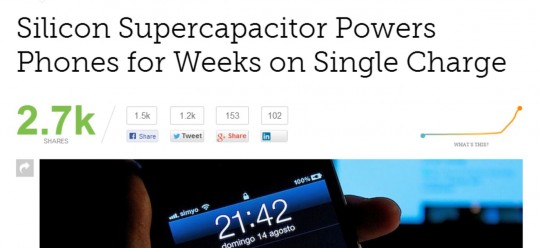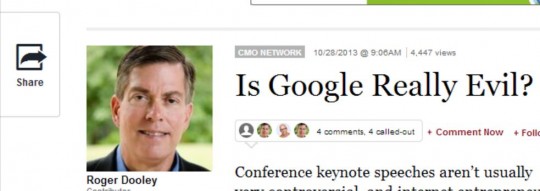Brilliant Social Proof Display by Mashable
Many, if not most, content sites today show how many social media shares each page or article has earned. This is a classic use of social proof, i.e., building credibility and earning additional shares by showing that others are doing it too. Like a restaurant with a line extending out the door, an article with a large number of shares is presumed to be good. Mashable’s current design goes way beyond what most other sites do.

Most sites that display social media share counts, including this one, use a button with a little number over the top showing how many times the item was shared on that service. At a glance, the visitor can see the number of Facebook Likes, Google +1s, Tweets, and so on.
Mashable has taken the concept several steps farther. First, they calculate a total number of shares across all the tracked services and prominently display that number. This sum will always look bigger than the individual numbers for each service. And how prominent is it? Well, it’s red, it’s bold, and its font is larger than the article headline font. Arguably, it’s the first thing the eye will be drawn to on the page. While a visitor might not pay attention to the little numbers over the share buttons, it’s hard to ignore the giant display of total shares.
There’s also a feature Mashable calls a “velocity meter” – a little chart that shows how these shares happen over time. I’m not sure if this information is particularly informative to the average visitor, but it’s a graphic element that further draws attention to the fact that lots of other people are sharing the article.
Is there a downside?
A few years ago a study showed that a visitor was more likely to share an article if they thought they would be the first to do so. Unless a site misrepresents the number of shares by showing a “0,” though, that effect only works once. And the negative social proof of zero shares is hardly what most sites are looking for.
The only other downside to dynamically displaying social share counts is a practical one: doing so can slow page loads. Since displaying current numbers requires a page to query multiple services, if even one social site is sluggish in returning data the page will not show as completely loaded. In face, Forbes.com, where my Brainy Marketing blog appears, just adopted a design that hides social share numbers behind a hover-activated button. One of the advantages cited was an improvement in page load time.
What the visitor sees first at Forbes.com:

Hovering over the share button causes the icons and counts to appear:

Mashable seems to have solved the performance issue by tracking and serving its own data instead of relying on real-time queries to Facebook and the other sites. I saw no hesitation in loading the share data, either the big total or the individual numbers.
All in all, this is a great way to use social proof to demonstrate content popularity, strengthen credibility, and stimulate even more content sharing.
